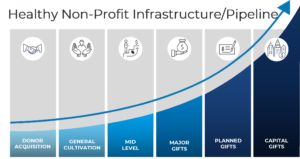Do You Need Goals for Mid-Level?
While more and more organizations are waking up to realize they need to develop a mid-level program, the whole concept of mid-level donors and...

It’s never been a good idea to have only one option in any situation. I learned that years ago when I found myself stuck in a nasty situation with no way out. What was the problem? I had relied on one path, one way, one option and decided it was irritating, frustrating and distracting to try to plan for anything else. I had all my eggs in one basket.
One reason I thought that way is that I could never imagine that the one path I had chosen would ever go bad. Kind of dumb, in retrospect. Really dumb. I mean, nothing in life is guaranteed.
But that’s how I thought.
I learned a lesson back then, and I can sum it up in one phrase: never just have one option. For anything.
And now I don’t. Every life situation I’m currently in, both personal and professional, contains a variety of options already planned out in quite a bit of detail.
Now, some would say that’s a little over the top. OK, that’s fine. You don’t have to go that far. For me it gives me comfort and security. But for you, you need to have more than one option (at least) for all of your life circumstances.
And if you’re a leader or manager in a non-profit, please hear me out. You DO need other options for revenue. And you need to work on it right now. Because, for many non-profits, this pandemic has proven that reliance on just a few sources of revenue is a perilous and fatal situation to be in.
But now you’re in it. And, in some cases, just scratching to get by. What should you do? Here’s what we suggest:
I’m going to talk about the first step now, then I’ll deal with the other three in the posts that follow.
Here’s a graphic of what a healthy donor pipeline looks like. This graph, as it is, could be for all the individual donors on your file. You could also do another one for institutions and simply remove planned giving from that one. Here’s the question. Are you fully functional in EACH of these areas in your organization? Do you have an effective strategy in each area?
Here’s the question. Are you fully functional in EACH of these areas in your organization? Do you have an effective strategy in each area?
If not, this is something to work on right now.
Many non-profits don’t have a strong enough donor acquisition program that feeds the pipeline with sufficient donors who are committed to the cause of the organization. You need:
The additional problem is that there is dysfunction and lack of effectiveness along the pipeline, causing donor value attrition and donor attrition. I’ll talk more about this in my next post, where I’ll give you a specific exercise to factually identify pipeline weakness.
So think about your donor pipeline. Is it healthy? It is fully functional? If not, there’s work to do. Stay tuned for my next post, where we’ll help you figure it out.
In the meantime, stay positive, healthy and confident. You’re in a good organization. Your cause is worthy of support. And there are good solid donors who will support you. You just have to have a good plan.
Richard

While more and more organizations are waking up to realize they need to develop a mid-level program, the whole concept of mid-level donors and...

Often, the reason the major gifts function in an organization doesn’t work is because the organization itself isn’t organized properly. Or the...

There is a big banner that drapes down from the ceiling in the gym I go to every day. It says, “Discipline is Freedom.” I think about this concept...